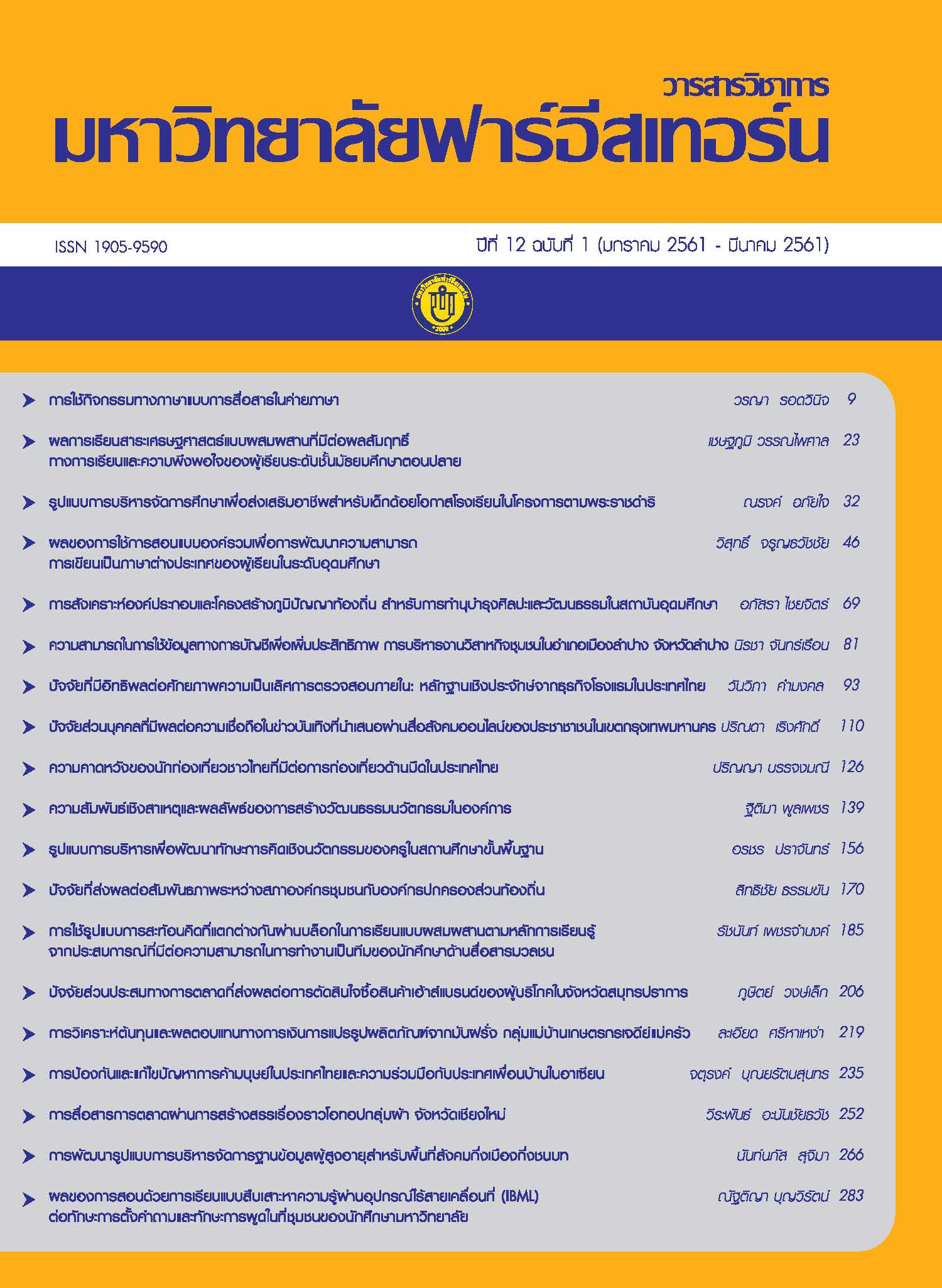ความคาดหวังของนักท่องเที่ยวชาวไทยที่มีต่อการท่องเที่ยวด้านมืดในประเทศไทย
Main Article Content
Abstract
งานวิจัยนี้มีวัตถุประสงค์เพื่อ1) ศึกษาพฤติกรรมการท่องเที่ยวด้านมืดในประเทศของนักท่องเที่ยวชาวไทย2) ศึกษาความคาดหวังของนักท่องเที่ยวชาวไทยที่มีต่อการท่องเที่ยวด้านมืดในประเทศไทย 3) เปรียบเทียบความคาดหวังของนักท่องเที่ยวชาวไทยที่มีต่อการท่องเที่ยวด้านมืดในประเทศไทย จำแนกตามปัจจัยส่วนบุคคล และ 4) ศึกษาความสัมพันธ์ระหว่างความคาดหวังและพฤติกรรมของนักท่องเที่ยวชาวไทยที่มีต่อการท่องเที่ยวด้านมืดในประเทศไทย กลุ่มตัวอย่างคือนักท่องเที่ยวชาวไทยที่มีการท่องเที่ยวด้านมืดในประเทศไทย จำนวน 400 รายการเก็บข้อมูลโดยใช้แบบสอบถาม การวิเคราะห์ข้อมูลใช้สถิติเชิงพรรณนา (Descriptive Statistics) ได้แก่ความถี่ร้อยละค่าเฉลี่ยส่วนเบี่ยงเบนมาตรฐานและสถิติเชิงอนุมาน (Inferential Statistics) ได้แก่การทดสอบความแตกต่างของค่าเฉลี่ยของสองกลุ่มตัวอย่าง (t-test) การทดสอบความแตกต่างของค่าเฉลี่ยมากกว่าสองกลุ่มตัวอย่าง (One-Way ANOVA) การเปรียบเทียบค่าเฉลี่ยเป็นรายคู่ด้วยวิธี Least Significant Difference (LSD) และการหาค่าความสัมพันธ์ ไคสแควร์ (Chi-Square)
ผลการวิจัยพบว่า
- นักท่องเที่ยวชาวไทยส่วนใหญ่สนใจการท่องเที่ยวด้านมืดจากสื่อออนไลน์ ต้องการทราบความรู้ทางประวัติศาสตร์ สนใจท่องเที่ยวเส้นทางรถไฟสายมรณะ ท่องเที่ยวแบบเดินทางไปกลับ ท่องเที่ยวเพราะความใคร่รู้ เพื่อนและคนรู้ใจมีส่วนร่วมในการตัดสินใจท่องเที่ยว และใช้รถยนต์ส่วนตัวในการเดินทาง
- ความคาดหวังของนักท่องเที่ยวชาวไทยที่มีต่อการท่องเที่ยวด้านมืดในประเทศไทย ในภาพรวมอยู่ในระดับมากที่สุด เมื่อพิจารณารายด้านพบว่า ด้านความปลอดภัยมาเป็นอันแรก ส่วนด้านกิจกรรมมาเป็นอันดับสุดท้าย
- นักท่องเที่ยวชาวไทยที่มีอายุ สถานภาพ อาชีพ รายได้เฉลี่ยต่อเดือน และภูมิลำเนา ต่างกัน มีความคาดหวังต่อการท่องเที่ยวด้านมืดในประเทศไทยแตกต่างกัน อย่างมีนัยสำคัญสถิติที่ 0.05
- ความคาดหวังและพฤติกรรมของนักท่องเที่ยวชาวไทยที่มีต่อการท่องเที่ยวด้านมืดในประเทศส่วนใหญ่มีความสัมพันธ์กันอย่างมีนัยสำคัญสถิติที่ 0.05
The research aims 1) to study Thai tourists’ behaviors toward dark tourism in Thailand, 2) to study Thai tourists’ expectation toward dark tourism in Thailand, 3) to compare Thai tourists’ expectation toward dark tourism in Thailand, classified by personal factors, and 4) to study a relationship between Thai tourists’ expectation and behaviors toward dark tourist in Thailand. A total sample of 400 Thai tourists, who prefer dark tourism in Thailand, was used in this research. Questionnaire was employed as data collection tool. Descriptive statistics used included frequency, percentage, mean and standard deviation. Also, inferential statistics used included t-test, One-Way ANOVA, Least Significant Difference (LSD) and Chi-Square.
The result showed that:
- Most Thai tourists are interested in dark tourism in Thailand due to online media; they would like to know dark tourism’ history; they are interested in death railway world war II; they prefer one-day trip; they are eager to know dark tourism; their friends and sole-mates influence their decision on dark tourism; and they prefer using their own car for travelling.
- In overall, Thai tourists’ expectation toward dark tourism in Thailand is in the highest level. When it comes to each component, safety comes first whilst activity comes last.
- Thai tourists who have difference in age, status, occupation, average monthly income, and domicile differently expect toward dark tourism in Thailand at 0.05 statistical significance.
- There is a great number of a 0.05 statistically significant relationship between Thai tourists’ expectation and behaviors toward dark tourism in Thailand.
Article Details
1. Any views and comments in the Journal of Social Innovation and Lifelong Learning are the authors’ views. The editorial staff have not to agree with those views and it is not considered as the editorial’s responsibility.
2. The responsibility of content and draft check of each article belongs to each author. In case, there is any lawsuit about copyright infringement. It is considered as the authors’ sole responsibility.
3. The article copyright belonging to the authors and The Far Eastern University are copyrighted legally. Republication must be received direct permission from the authors and The Far Eastern University in written form.
References
กมลทิพย์ ชูประทีป. (2547). ปัจจัยที่มีความสําคัญต่อการตัดสินใจเดินทางท่องเที่ยวเชิงเกษตรอําเภอวังน้ำเขียว จังหวัดนครราชสีมา. วิทยานิพนธ์บริหารธุรกิจมหาบัณฑิต มหาวิทยาลัยมหาสารคาม.
ปัญญา ซิ้มสื่อ. (2547). ความพึงพอใจของนักท่องเที่ยวไทยต่อการบริการท่องเที่ยวอุทยานแห่งชาติเขาแหลมหญ้า-หมู่เกาะเสม็ดจังหวัดระยอง. วิทยานิพนธ์ศิลปศาสตรมหาบัณฑิต สาขาสังคมศาสตร์ เพื่อการพัฒนา, มหาวิทยาลัยราชภัฏรําไพพรรณี.
ยูงทอง รวมสุข. (2549). ข้อมูลพื้นฐานของนักท่องเที่ยว พฤติกรรมการเดินทาง และความพึงพอใจในคุณภาพบริการทางการท่องเที่ยว ในการพยากรณ์ความตั้งใจกลับมาเที่ยวจังหวัดภูเก็ตซ้ำของ นักท่องเที่ยวชาวไทย. การค้นคว้าแบบอิสระวิทยาศาสตรมหาบัณฑิต สาขาวิชาจิตวิทยาอุตสาหกรรมและองค์การ บัณฑิตวิทยาลัย มหาวิทยาลัยเชียงใหม่. สำนักงานคณะกรรมการธุรกรรมทางอิเล็กทรอนิกส์. (2556) ค้นเมื่อ 10 มีนาคม 2559 จาก
http://www.etcommission.go.th/home/article-other-topic-travel-ecommerce.html
เสาวนีย์ กันทะแสน. (2547). ความคาดหวังและความพึงพอใจของนักท่องเที่ยวต่อการจัดสภาพแวดล้อมและกิจกรรมทางการท่องเที่ยวกรณีศึกษา: หมู่บ้านรวมมิตรอําเภอเมืองจังหวัดเชียงราย. วิทยานิพนธ์ ปริญญาศิลปศาสตรมหาบัณฑิต สาขาการจัดการอุตสาหกรรมการท่องเที่ยว มหาวิทยาลัยเชียงใหม่.
อภิชาต อินทร์พงพันธ์. (2540). อุตสาหกรรมการท่องเที่ยว. กรุงเทพฯ: อุบลกิจ ออฟเซ็ท.
Cochran, W.G. (1953). Sampling Techiques. New York : John Wiley & Sons. Inc.
Kotler, Philip. (2003). Marketing Management. 11th ed. Upper Sanddle River, New Jersey:
Prentice Hall.
Kotler, Philip and Keller, Kevin Lane., (2012). Marketing Management. 12th Edition, Edinburgh
Gate: Pearson Education Limited.
Stone P.R. (2006). A Dark Tourism Spectrum: towards a typology of death and macabre related tourist sites, attractions and exhibitions. University of Central Lancashire.
Stone P. R. and Sharpley R (2008) Consuming Dark Tourism: A Thanatological Perspective. Annals of
Tourism Research, 35(2): 574-595.
Stone P.R. (2010) Dark Tourism Experiences: Mediating between Life and Death. In R.Sharpley and
P.R.Stone (eds) Tourist Experiences: Contemporary Perspectives, London: Routledge.

